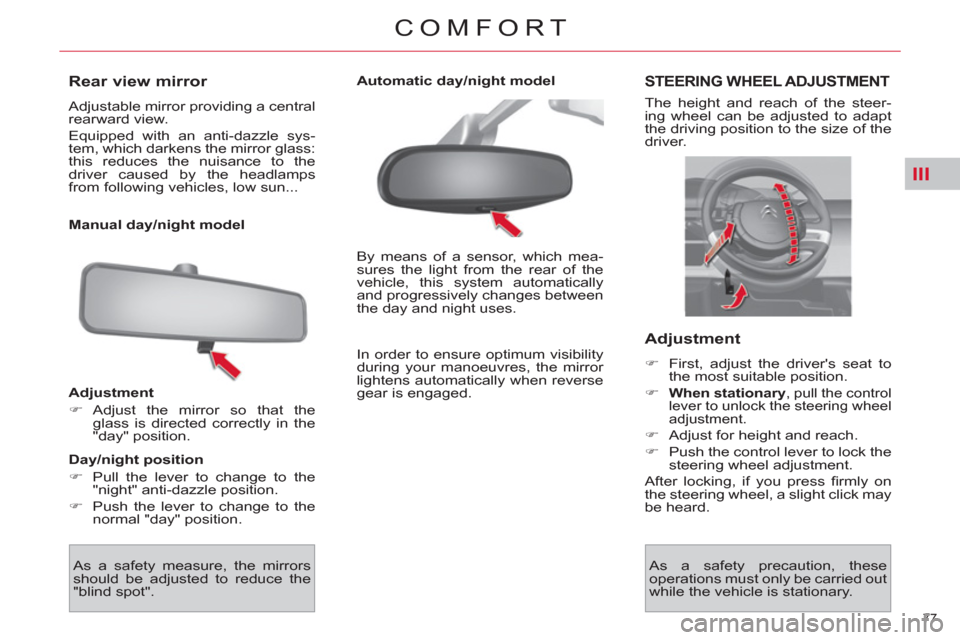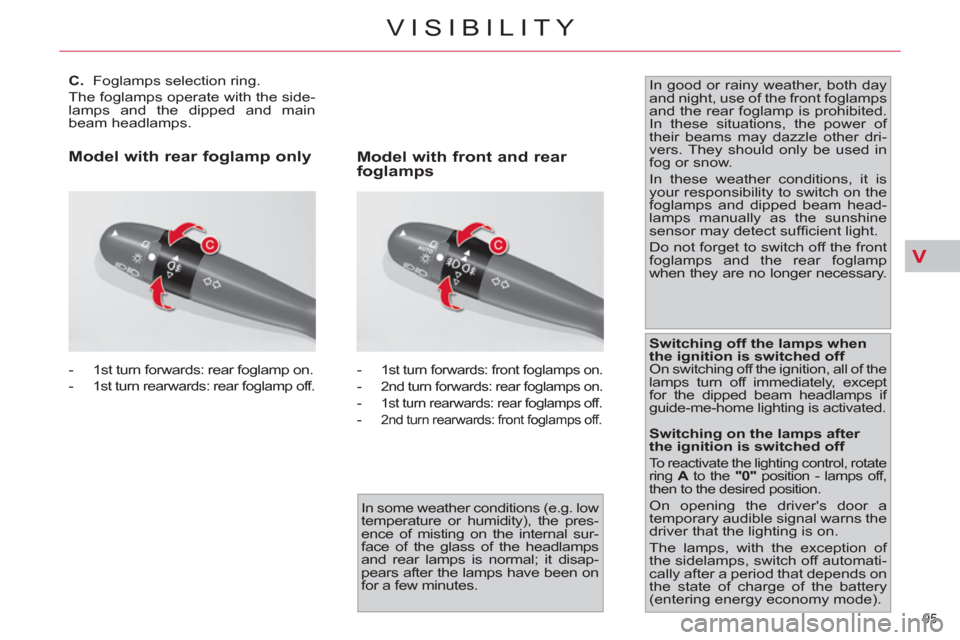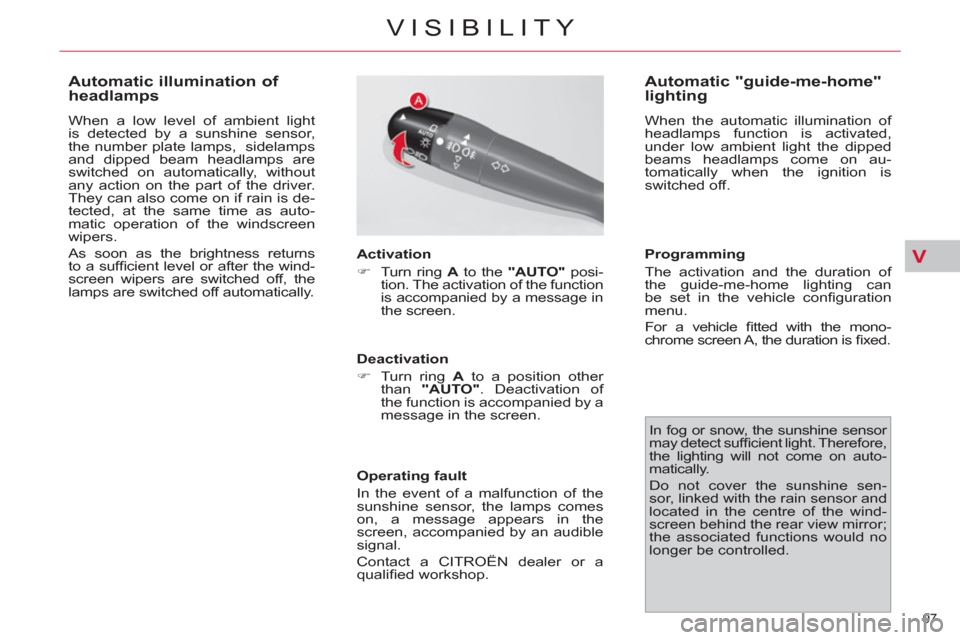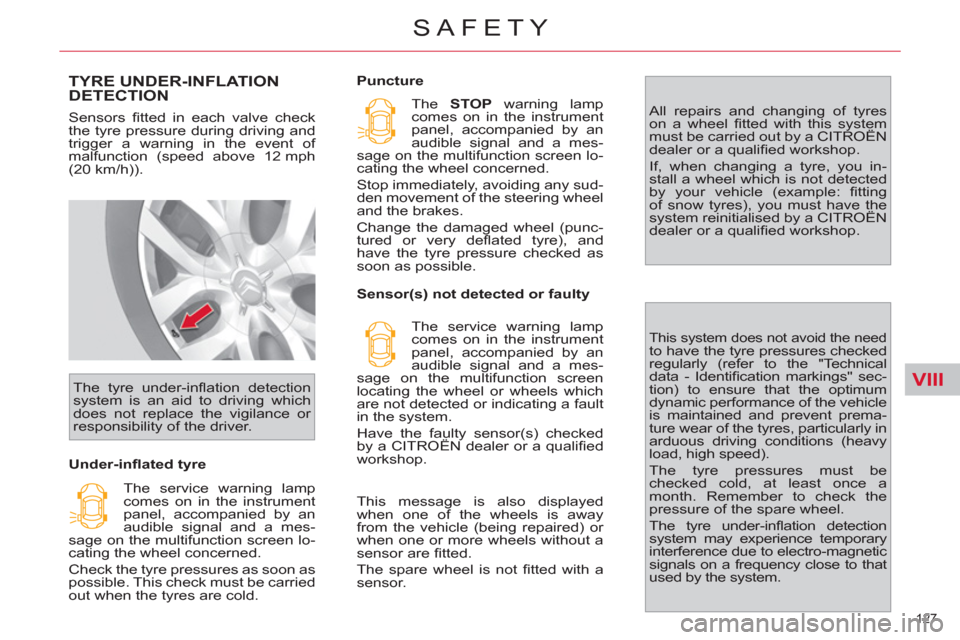sensor Citroen C4 PICASSO RHD 2012 1.G User Guide
[x] Cancel search | Manufacturer: CITROEN, Model Year: 2012, Model line: C4 PICASSO RHD, Model: Citroen C4 PICASSO RHD 2012 1.GPages: 352, PDF Size: 9.91 MB
Page 59 of 352

III
57
COMFORT
Air conditioning
To ensure that your system operates
correctly, it is recommended that you
have it checked regularly.
Water arising from condensation
in the air conditioning drains away
through a hole provided for this pur-
pose. A pool of water may thus form
under the vehicle when stationary.
To preserve the sealing of the air
conditioning compressor, operate
the air conditioning at least once a
month.
Regardless of the season, the air
conditioning is useful, since it re-
moves humidity and condensation.
To be effective, the air conditioning
should only be used with the win-
dows closed.
If after a lengthy stop in bright sunlight
the interior temperature is excessive,
air the passenger compartment by
opening the windows for a few mo-
ments, then close them again.
The air conditioning operates by using
power from the engine. This results in
a slight increase in fuel consumption.
Dust filter/Odour filter (active
carbon)
There is a fi lter for excluding odours
and dust.
This fi lter has to be changed in ac-
cordance with the vehicle's servicing
schedule (see the servicing booklet).
Air circulation
Air vents on the fl oor underneath the
front seats provide enhanced heat-
ing for the rear seat positions; take
care not to obstruct them.
Air vents
The air vents to the face have grilles
and thumb wheels to adjust the air
fl ow and direction (up-down, right-
left).
The automatic regulation of the air
conditioning in the passenger com-
partment uses a number of sensors
(sunshine sensor, ambient tempera-
ture sensor...) that relieve you of the
need to make frequent adjustments to
the displayed temperature.
Take care not to obstruct the sun-
shine sensor, located on the dash-
board behind the instrument panel.
Sensors
Page 79 of 352

III
77
COMFORT
Rear view mirror
Adjustable mirror providing a central
rearward view.
Equipped with an anti-dazzle sys-
tem, which darkens the mirror glass:
this reduces the nuisance to the
driver caused by the headlamps
from following vehicles, low sun...
Manual day/night model
Adjustment
�)
Adjust the mirror so that the
glass is directed correctly in the
"day" position.
Day/night position
�)
Pull the lever to change to the
"night" anti-dazzle position.
�)
Push the lever to change to the
normal "day" position.
By means of a sensor, which mea-
sures the light from the rear of the
vehicle, this system automatically
and progressively changes between
the day and night uses.
STEERING WHEEL ADJUSTMENT
The height and reach of the steer-
ing wheel can be adjusted to adapt
the driving position to the size of the
driver.
Adjustment
�)
First, adjust the driver's seat to
the most suitable position.
�)
When stationary
, pull the control
lever to unlock the steering wheel
adjustment.
�)
Adjust for height and reach.
�)
Push the control lever to lock the
steering wheel adjustment.
After locking, if you press fi rmly on
the steering wheel, a slight click may
be heard.
As a safety measure, the mirrors
should be adjusted to reduce the
"blind spot".
Automatic day/night model
As a safety precaution, these
operations must only be carried out
while the vehicle is stationary.
In order to ensure optimum visibility
during your manoeuvres, the mirror
lightens automatically when reverse
gear is engaged.
Page 97 of 352

V
95
VISIBILITY
C.
Foglamps selection ring.
The foglamps operate with the side-
lamps and the dipped and main
beam headlamps.
- 1
st turn forwards: rear foglamp on.
-
1
st turn rearwards: rear foglamp off.
- 1 st turn forwards: front foglamps on.
- 2 nd turn forwards: rear foglamps on.
- 1 st turn rearwards: rear foglamps off.
- 2 nd turn rearwards: front foglamps off.
Model with rear foglamp only
Model with front and rear
foglamps
In good or rainy weather, both day
and night, use of the front foglamps
and the rear foglamp is prohibited.
In these situations, the power of
their beams may dazzle other dri-
vers. They should only be used in
fog or snow.
In these weather conditions, it is
your responsibility to switch on the
foglamps and dipped beam head-
lamps manually as the sunshine
sensor may detect suffi cient light.
Do not forget to switch off the front
foglamps and the rear foglamp
when they are no longer necessary.
Switching off the lamps when
the ignition is switched off
On switching off the ignition, all of the
lamps turn off immediately, except
for the dipped beam headlamps if
guide-me-home lighting is activated.
In some weather conditions (e.g. low
temperature or humidity), the pres-
ence of misting on the internal sur-
face of the glass of the headlamps
and rear lamps is normal; it disap-
pears after the lamps have been on
for a few minutes.
Switching on the lamps after
the ignition is switched off
To reactivate the lighting control, rotate
ring A
to the "0"
position - lamps off,
then to the desired position.
On opening the driver's door a
temporary audible signal warns the
driver that the lighting is on.
The lamps, with the exception of
the sidelamps, switch off automati-
cally after a period that depends on
the state of charge of the battery
(entering energy economy mode).
Page 99 of 352

V
97
VISIBILITY
Automatic illumination of
headlamps
When a low level of ambient light
is detected by a sunshine sensor,
the number plate lamps, sidelamps
and dipped beam headlamps are
switched on automatically, without
any action on the part of the driver.
They can also come on if rain is de-
tected, at the same time as auto-
matic operation of the windscreen
wipers.
As soon as the brightness returns
to a suffi cient level or after the wind-
screen wipers are switched off, the
lamps are switched off automatically.
Activation
�)
Turn ring A
to the "AUTO"
posi-
tion. The activation of the function
is accompanied by a message in
the screen.
Deactivation
�)
Turn ring A
to a position other
than "AUTO"
. Deactivation of
the function is accompanied by a
message in the screen.
Operating fault
In the event of a malfunction of the
sunshine sensor, the lamps comes
on, a message appears in the
screen, accompanied by an audible
signal.
Contact a CITROËN dealer or a
qualifi ed workshop.
Automatic "guide-me-home"
lighting
When the automatic illumination of
headlamps function is activated,
under low ambient light the dipped
beams headlamps come on au-
tomatically when the ignition is
switched off.
In fog or snow, the sunshine sensor
may detect suffi cient light. Therefore,
the lighting will not come on auto-
matically.
Do not cover the sunshine sen-
sor, linked with the rain sensor and
located in the centre of the wind-
screen behind the rear view mirror;
the associated functions would no
longer be controlled.
Programming
The activation and the duration of
the guide-me-home lighting can
be set in the vehicle confi guration
menu.
For a vehicle fi tted with the mono-
chrome screen A, the duration is fi xed.
Page 103 of 352

V
101
VISIBILITY
Reverse gear
When reverse gear is engaged, the
rear wiper will come into operation if
the windscreen wipers are operating.
Programming
The function is activated
or deactivated via the
vehicle confi guration
menu.
This function is activated
by default.
Windscreen and headlamp
wash
�)
Pull the windscreen wiper stalk
towards you. The windscreen
wash then the windscreen wipers
operate for a fi xed period.
The headlamp washers only operate
when the dipped beam headlamps
are on
.
Automatic rain sensitive
windscreen wipers
The windscreen wipers operate au-
tomatically, without any action on the
part of the driver, if rain is detected
(sensor behind the rear view mirror),
adapting their speed to the intensity
of the rainfall.
This is controlled manually by the
driver by pushing the stalk down-
wards to the "AUTO"
position.
It is accompanied by a message in
the screen. The automatic rain sensitive wipers
must be reactivated if the ignition has
been off for more than one minute,
by pushing the stalk downwards.
Operating fault
If an automatic wiping malfunction
occurs, the wipers will operate in in-
termittent mode.
Have it checked by a CITROËN dealer
or a qualifi ed workshop.
Do not cover the rain sensor, linked
with the sunshine sensor and locat-
ed in the centre of the windscreen
behind the rear view mirror.
Switch off the automatic rain sen-
sitive wipers when using an auto-
matic car wash.
In winter, to avoid damaging the
wiper blades, it is advisable to wait
until the windscreen is completely
clear of ice before activating the
automatic rain sensitive wipers.
Activation
Switching off
This is controlled manually by the
driver by moving the stalk upwards
then returning it to position "0"
.
It is accompanied by a message in
the screen.
Page 129 of 352

VIII
127
SAFETY
TYRE UNDER-INFLATION DETECTION
Sensors fi tted in each valve check
the tyre pressure during driving and
trigger a warning in the event of
malfunction (speed above 12 mph
(20 km/h)).
Under-infl ated tyre The tyre under-infl ation detection
system is an aid to driving which
does not replace the vigilance or
responsibility of the driver.
Puncture
The service warning lamp
comes on in the instrument
panel, accompanied by an
audible signal and a mes-
sage on the multifunction screen lo-
cating the wheel concerned.
Check the tyre pressures as soon as
possible. This check must be carried
out when the tyres are cold. The STOP
warning lamp
comes on in the instrument
panel, accompanied by an
audible signal and a mes-
sage on the multifunction screen lo-
cating the wheel concerned.
Stop immediately, avoiding any sud-
den movement of the steering wheel
and the brakes.
Change the damaged wheel (punc-
tured or very defl ated tyre), and
have the tyre pressure checked as
soon as possible.
Sensor(s) not detected or faulty
The service warning lamp
comes on in the instrument
panel, accompanied by an
audible signal and a mes-
sage on the multifunction screen
locating the wheel or wheels which
are not detected or indicating a fault
in the system.
Have the faulty sensor(s) checked
by a CITROËN dealer or a qualifi ed
workshop. All repairs and changing of tyres
on a wheel fi tted with this system
must be carried out by a CITROËN
dealer or a qualifi ed workshop.
If, when changing a tyre, you in-
stall a wheel which is not detected
by your vehicle (example: fi tting
of snow tyres), you must have the
system reinitialised by a CITROËN
dealer or a qualifi ed workshop.
This system does not avoid the need to have the tyre pressures checked
regularly (refer to the "Technical
data - Identifi cation markings" sec-
tion) to ensure that the optimum
dynamic performance of the vehicle
is maintained and prevent prema-
ture wear of the tyres, particularly in
arduous driving conditions (heavy
load, high speed).
The tyre pressures must be
checked cold, at least once a
month. Remember to check the
pressure of the spare wheel.
The tyre under-infl ation detection
system may experience temporary
interference due to electro-magnetic
signals on a frequency close to that
used by the system.
This message is also displayed
when one of the wheels is away
from the vehicle (being repaired) or
when one or more wheels without a
sensor are fi tted.
The spare wheel is not fi tted with a
sensor.
Page 162 of 352

IX
160
DRIVING
FIXED CENTRED CONTROLS STEERING WHEEL
Cruise control/speed limiter
and parking sensor controls
1.
Activation of the parking
sensors function.
2.
Selection of cruise control or
speed limiter.
3.
Activation/Deactivation of speed
limiter.
Deactivation/Reactivation of
cruise control.
4.
Increase speed/Activation of
cruise control.
5.
Decrease speed/Activation of
cruise control.
Audio system controls
A.
Volume decrease.
B.
Volume increase.
C.
Search of higher frequencies.
D.
Scrolling pre-set stations.
E.
Mute.
(see "Audio and Telematics" section)
Page 168 of 352

IX
166
DRIVING
PARKING SPACE SENSORS
After measuring the parking space
available between two vehicles or
obstacles, this system gives you in-
formation on:
- the possibility of fi tting into a free
space, depending on the dimen-
sions of your vehicle and the dis-
tances needed for manoeuvring,
- the level of diffi culty of the ma-
noeuvre to be performed.
The system does not measure spaces
which are clearly much smaller or
larger than the size of the vehicle.
Displays in the instrument
panel
The parking space sensor
function warning lamp can
have three different states:
- off:
the function is not selected,
- on fi xed:
the function is selected
but the conditions for measure-
ment are not yet met (direction
indicator not operating, speed
too high) or the measurement
phase has ended,
- fl ashing:
measurement is in
progress or the message is be-
ing displayed. You can activate the "parking space
sensor" function by pressing but-
ton A. The fi xed illumination of the
warning lamp indicates that the
function is selected.
Page 169 of 352

IX
167
DRIVING
Operation
You have identifi ed a parking
space:
�)
Press button A
to activate the
function.
�)
Activate the direction indicator
on the side where the space is to
be measured.
�)
During the measuring, go for-
ward the length of the space, at
a speed less than 12 mph (ap-
proximately 20 km/h), to prepare
for your manoeuvre.
The system then measures the
size of the space.
�)
The system informs you of the
level of diffi culty of the manoeu-
vre via a message in the multi-
function screen accompanied by
an audible signal.
Parking possible
Parking diffi cult
Parking not advised
The function displays the following
types of message: The function deactivates itself auto-
matically:
- when you engage reverse gear,
- when you switch off the ignition,
- fi ve minutes after activation of
the function or after the last mea-
surement operation,
- if the vehicle speed exceeds the
threshold of 45 mph (approxi-
mately 70 km/h) for one minute.
If there is a malfunction,
have the system checked
by a CITROËN dealer or a
qualifi ed workshop.
If the lateral distance between your
vehicle and the parking space is too
great, the system may not operate.
- The function remains available
after each measurement and so
can measure a number of places
successively.
- In bad weather or in winter, ensure
that the sensors are not covered
by dirt, or by ice or snow.
- The parking space sensor func-
tion deactivates the front parking
sensors during the space mea-
suring phase when you are in
forward gear.
Page 170 of 352

IX
168
DRIVING
LANE DEPARTURE
WARNING SYSTEM
System which detects the involun-
tary crossing of longitudinal traffi c
lane markings on the ground (solid
or broken line).
Sensors, fi tted below the front bum-
per, trigger a warning if the vehicle
drifts over a lane marking (speed
higher than 50 mph (80 km/h)).
This system is particularly useful on
motorways and main roads.
Activation
�)
Press this button, the indicator
lamp comes on.
Deactivation
�)
Press this button again, the indi-
cator lamp goes off.
The status of the system remains
in the memory when the ignition is
switched off.
Detection
You are warned by the vibration of
the driver's seat cushion:
- on the right-hand side, if the
marking on the ground has been
crossed on the right,
- on the left-hand side, if the marking
on the ground has been crossed
on the left.
No warning is transmitted while the
direction indicator is active and for
approximately 20 seconds after the
direction indicator is switched off.
A warning may be transmitted if a
direction marking (e.g. arrow) or
non-standard marking (e.g. graffi ti)
is crossed.
Operating fault
In the event of a malfunction, the
service warning lamp comes on, ac-
companied by an audible signal and
a message in the screen.
Contact a CITROËN dealer or a
qualifi ed workshop.
The lane departure warning sys-
tem cannot, in any circumstances,
replace the need for vigilance and
responsibility on the part of the
driver.
The detection may be impeded:
- if the sensors are dirty (mud,
snow...),
- if the markings on the ground
are worn,
-
if there is little contrast between
the markings on the ground and
the road surface.